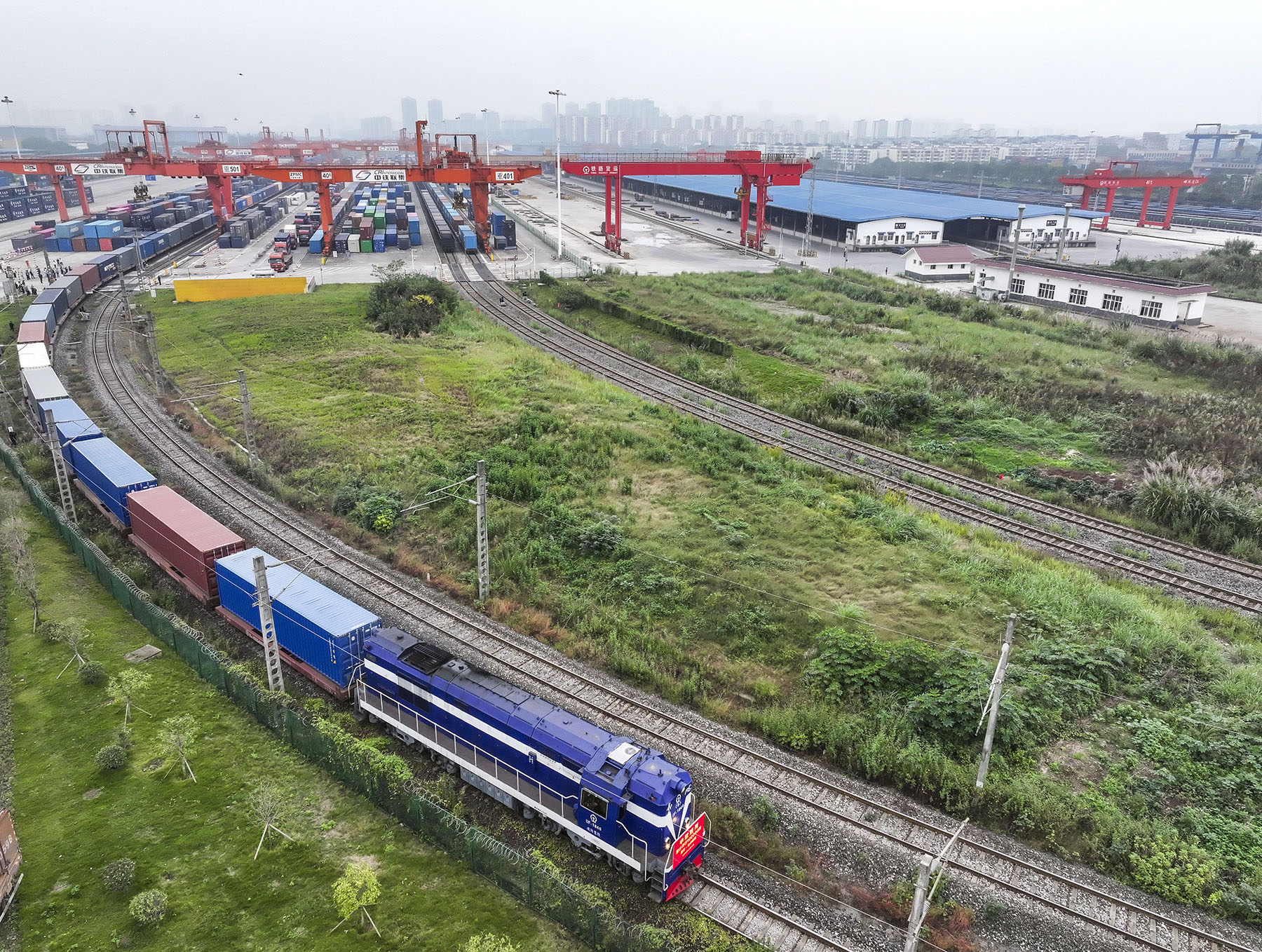Rail freight lines linking continents have served as key transport since 2011

WARSAW — Weekday mornings hum with urgency at the GD Poland shopping complex on the outskirts of Warsaw. Electric scooters laden with crates of Chinese goods dart between warehouses and loading docks, as merchants race to load shipments brought thousands of kilometers by China-Europe freight trains into vans bound for stores across Central and Eastern Europe.
What appears to be a chaotic delivery hub is, in reality, the final stop in an intricate supply chain connecting Chinese factories to European storefronts. It is a network that turns global trade routes into local livelihoods, fueling cross-continental cooperation.
Among the swift-moving scooter drivers at GD Poland is Lin Jiangliang, a Chinese merchant who, alongside with his wife Hong Meili, has spent the past decade running a lingerie business there.
READ MORE: Trade, trains and tech driving China-Europe connections forward
Drawn to Poland in 2014, three years after the launch of China-Europe freight trains, the couple saw opportunity in a country fast becoming Europe's logistical gateway, as most trains entering the European Union from the east pass through Malaszewicze, a critical border town in Poland.
"We soon realized that reselling factory-made products wouldn't set us apart," Hong said. Instead, they created their own brand, designing styles based on emerging fashion trends and customer preferences.
China-Europe freight trains quickly became the backbone of their operation. Digital sketches sent to factories in China are transformed into samples and shipped within two weeks, allowing their shelves to stay stocked with the latest designs.
To meet growing demand, Lin hired a local porter and a salesperson, relying on scooters to shuttle goods. Orders averaging dozens of kilograms per shipment are packed and delivered with speed, demonstrating the resourcefulness and hard work that small-scale merchants need to survive and thrive.
Their story mirrors a broader picture of commerce at GD Poland, where about 900 businesses specialize in textiles, appliances and household goods — 90 percent of which are sourced from China, according to Wang Qi, the center's deputy general manager.
Similar trading hubs have flourished across Europe over the past few decades, from Aubervilliers in France to Fuenlabrada in Spain. In 2023 alone, China exported $169 billion worth of light industrial products to the EU and Britain, supplying affordable goods to consumers while supporting jobs on both sides of the supply chain.
"What keeps me optimistic about the future is how connected we are — suppliers, distributors and us. It's not just business — it's a shared rhythm that keeps products and ideas moving," Lin said.
Thirteen years ago, the idea of freight trains crossing the vast Eurasian continent seemed "crazy" to many, recalled Markus Bangen, CEO of Duisburger Hafen AG(Duisport). Today, it is a reality reshaping cross-continental trade and logistics.
Since 2011, when the first China-Europe freight train left the southwestern Chinese city Chongqing, for Duisburg, Germany, the network has grown to connect 227 European and 100 Asian cities. Over the past 13 years, more than 11 million twenty-foot equivalent units of goods worth more than $420 billion have passed over the transcontinental track network.

In Duisburg, a former industrial stronghold, freight rail has spurred reinvention. The port now handles 4 million containers annually, with over 100 Chinese logistics and e-commerce firms establishing operations around it. Similar transformations have turned Malaszewicze and Spain's Valladolid into thriving logistic hubs.
The network continues to grow. In November, a shipment of electric vehicles made its way from Chengdu, Sichuan province, to Georgia's Tbilisi via rail, sea and road, traversing Kazakhstan and the Caspian Sea region. This new route launched in July runs through the Middle Corridor — a vital trade link across Central Asia and the South Caucasus — providing a reliable alternative to traditional shipping lanes amid geopolitical uncertainties.
For Fan Yuliang, a warehouse manager of AUKLogis GmbH, a German subsidiary of Chinese logistics firm Western Post, the China-Europe freight trains have redefined what's possible. "I thought I'd handled all kinds of cargo, but seeing an entire vehicle loaded into a shipping container still amazed me," he recalled.
By 2023, China-Europe freight trains had transported more than 50,000 types of goods, ranging from Chinese exports like textiles and industrial machinery to European exports such as motorcycles, medical equipment and agricultural produce.
Bangen described the service as a transformative transportation model that replaces traditional shipping routes and unlocks trade opportunities once out of reach.
As freight trains bridge continents, Chinese and European firms are joining forces to shape the future of mobility — this time, on wheels of electric vehicles.
In Berlin, Chinese EV manufacturer NIO has established a research and development center focused on smart driving technologies and energy solutions. Its engineers are working on adaptive driving systems, battery-swapping infrastructure and integrated power grids to meet European standards.
ALSO READ: Brisk year of vehicle sales shows no sign of stopping
"Our goal is to adapt rapidly to European markets while driving the next wave of innovation," Wei Hezeng, head of NIO Europe's Smart Driving Technology Center, told Xinhua News Agency.
His vision is echoed by Patrick Stumfol, senior system engineer at NIO Europe. "The combination of German engineering precision and Chinese tech innovation creates a very dynamic environment here," Stumfol said.
Though the EU seeks to shield its market with protectionist tariffs, European carmakers are opting for collaboration over confrontation.
The collaborative momentum extends beyond Berlin. In Spain, Chery has teamed up with Ebro to develop EVs, while BYD is building manufacturing plants in Hungary. European automakers are embracing the trend likewise — Volkswagen has invested $700 million in XPeng for joint EV development, and Stellantis committed 1.5 billion euros ($1.56 billion) to Leapmotor for research, production and overseas expansion.
Carlos Tavares, Stellantis' former CEO, captured this partnership approach, saying the best way to compete with China is to partner with their automakers and "hop on their train".


